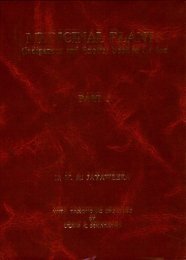Print this article
Print this article
Print this article
Create successful ePaper yourself
Turn your PDF publications into a flip-book with our unique Google optimized e-Paper software.
DISCUSSION<br />
In all the water samples tested, the total<br />
coliform and faecal coliform counts far exceeded<br />
those stipulated by the Sri Lanka Standards<br />
Institute and the WHO respectively, for<br />
drinking water (0-10 cfu and 0 cfu/100ml of<br />
water respectively) and bathing water (1000 cfu<br />
and 200 cfu/100ml of water respectively). These<br />
counts were significantly higher in the populated<br />
area and the sociological survey confirmed that<br />
faecal matter is directly disposed into the stream<br />
at <strong>this</strong> location due to the lack of proper toilet<br />
facilities and poor sanitary conditions of the<br />
community. The mixed sources (animal and<br />
human) of faecal pollution in the other locations,<br />
is largely due to the run off from the diary farm<br />
and piggery.<br />
The increase in water temperature down<br />
stream is attributed to the difference in elevation,<br />
as the forested area is located at 900 m and the<br />
university premises at 470 m. The high turbidity<br />
in the wet season in all four locations is to be<br />
expected. However, the very high turbidity level<br />
in the agricultural area is a result of paddy<br />
cultivation, during which large amounts of top<br />
soil gets washed into the stream.<br />
The decrease in pH during the wet season is<br />
due to the high rain fall that was received, as<br />
even unpolluted rain water is slightly acidic with<br />
a pH between 5 and 6. The lowest pH of water<br />
near the populated area (line houses) is probably<br />
due to the large amount of household refuse that<br />
is discharged directly into the stream at <strong>this</strong><br />
location. Decomposition of organic matter<br />
produces CO2, which dissolves in water as<br />
carbonic acid, thereby lowering the pH.<br />
The sociological survey revealed that all<br />
communities were not satisfied with the quality<br />
of water in the stream flowing near their homes<br />
and blamed the occupants in the populated area<br />
and the University livestock farms for polluting<br />
the stream. The need to implement regulations,<br />
as suggested by occupants themselves, regarding<br />
disposal of solid waste and waste water into the<br />
stream is paramount to make Maha Oya waters<br />
safe for bathing and drinking, specially in<br />
relation to microbial activity.<br />
C.L. Abayasekara, C.L. Siriwardana and M.G.M Razaak<br />
REFERENCES<br />
137<br />
American Society for Microbiology. (2002).<br />
Applied and Environmental Microbiology. 68<br />
(12): 5796-5803.<br />
American Public Health Association. (1992).<br />
Standard methods for examination of water and<br />
wastewater, American Public Health<br />
Association, Washington, DC.<br />
Bisen, P.S. and Verma, K. (1994). Handbook of<br />
Microbiology, CBS Publishers & Distributors.<br />
Pp.134-145.<br />
Black, J.B. (1993). Microbiology, principles and<br />
applications. Prentice Hall. Pp. 864.<br />
Fink, A. and Kosecoff, J. (1985). How to<br />
Conduct Surveys. SAGE Publications. Pp.117.<br />
Iman, U. (1998). Water quality in Maha Oya.<br />
M. Sc. Thesis. University of Peradeniya, Sri<br />
Lanka. Pp. 260.<br />
Pourcher, A.M., Devriese, I.A., Hernandez J.F.<br />
and Delattre J.M. (1991). Enumeration by a<br />
miniaturized method of E. coli, Streptococcus<br />
bovis and enterococci as indicators of the origin<br />
of faecal pollution in waters. J. Appl. Bacteriol.<br />
70: 525-530.<br />
Toronzos, G.A, McFeters, G.A. (1997).<br />
Detection of indicator microorganisms in<br />
environmental freshwaters & drinking waters.<br />
Manual of environmental microbiology,<br />
American Society for Microbiology. Pp. 184 -<br />
193.
















